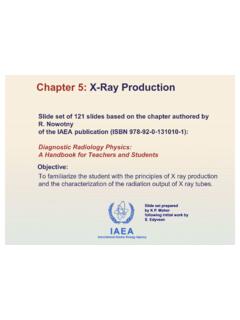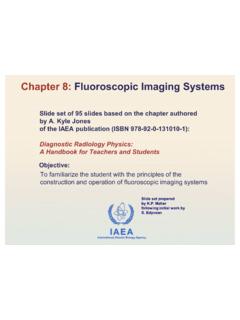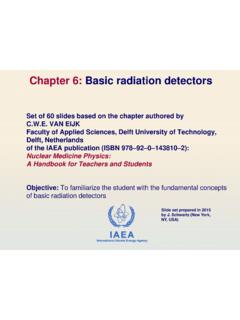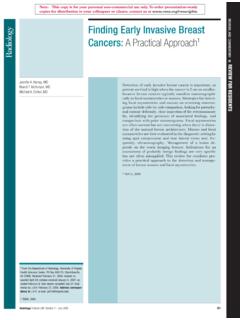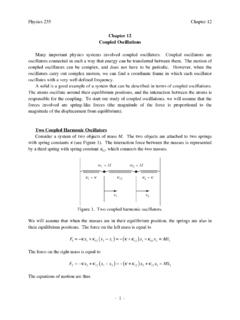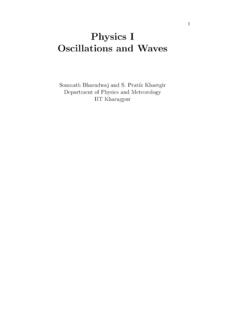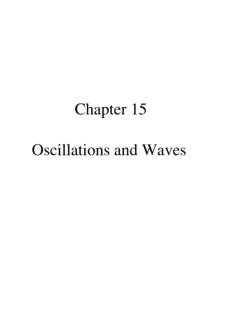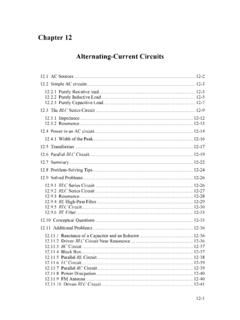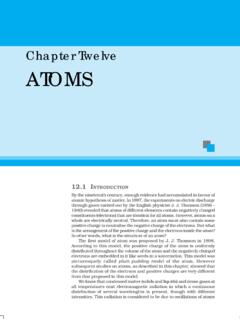Transcription of Chapter 12:Physics of Ultrasound - Human Health Campus
1 IAEAI nternational Atomic Energy AgencySlide set of 54 slides based on the Chapter authored Lacefieldof the IAEA publication (ISBN 978-92-0-131010-1):Diagnostic Radiology Physics: A Handbook for Teachers and StudentsObjective:To familiarize students with Physics or Ultrasound , commonly used in diagnostic imaging 12:Physics of UltrasoundSlide set preparedby (S. Paulo, Brazil, Institute of Physics of S. Paulo University) . Introduction . Ultrasonic Plane . Ultrasonic Properties of Biological . Ultrasonic . Doppler . Biological Effects of UltrasoundChapter OF CONTENTSD iagnostic Radiology Physics: a Handbook for Teachers and Students Chapter 12, INTRODUCTIOND iagnostic Radiology Physics: a Handbook for Teachers and Students Chapter 12,3 Ultrasoundis an acoustic wave with frequencies greater than the maximum frequency audible to humans, which is 20 kHz Ultrasoundis the most commonly used diagnostic imaging modality, accounting for approximately 25% of all imaging examinations performed worldwide nowadaysIAEAD iagnostic Radiology Physics.
2 A Handbook for Teachers and Students Chapter 12, INTRODUCTION Diagnostic imagingis generally performed using Ultrasound in the frequency range from2 to 15 MHz The choice of frequencyis dictated by a trade-off between spatial resolutionand penetration depth, since higher frequency waves can be focused more tightly but are attenuated more rapidly by tissueThe information in an ultrasonic imageis influenced by the physical processesunderlying propagation, reflection and attenuation of Ultrasound waves in INTRODUCTIOND iagnostic Radiology Physics: a Handbook for Teachers and Students Chapter 12,5 Attractive characteristics: relatively low cost portability of an Ultrasound scanner the non-ionizing nature of Ultrasound waves the ability to produce real-time images of blood flowand moving structures such as the beating heart the intrinsic contrast among soft tissue structures thatis achieved without the need for an injected INTRODUCTIOND iagnostic Radiology Physics: a Handbook for Teachers and Students Chapter 12,6 Ultrasoundhas a wide range of medical applications.
3 Cardiac and vascular imaging imaging of the abdominal organs in uteroimaging of the developing fetus Ongoing technological improvements continue to expand the use of Ultrasound for many applications: cancer imaging musculoskeletal imaging ophthalmology ULTRASONIC PLANE WAVESD iagnostic Radiology Physics: a Handbook for Teachers and Students Chapter 12,7 Anacoustic waveis atravelingpressure disturbancethat produces alternating compressions rarefactions(expansions) of the propagationmediumThe compressionsand rarefactionsdisplace incremental volumes of the medium and the wave propagates via transfer of momentum among incremental volumes Each incremental volume of the medium undergoes small oscillations about its original position but does not travelwith the pressure disturbanceIAEAD iagnostic Radiology Physics.
4 A Handbook for Teachers and Students Chapter 12, ULTRASONIC PLANE One-Dimensional Ultrasonic WavesA pressure plane wave, p (x,t), propagating along one spatial dimension, x, through a homogeneous, non-attenuating fluid medium can be formulated starting from Euler s equation and the equation of continuity:( )( )0,,= + txuttxpxo ( )( )0,1,= + txuxtxpt ois the undisturbed mass density of the medium is the compressibility of the medium ( , the fractional change in volume perunit pressure in units of Pa 1)u(x,t) is the particle velocity produced by the waveIAEAD iagnostic Radiology Physics: a Handbook for Teachers and Students Chapter 12,9( )( )0,,= + txuttxpxo ( )( )0,1,= + txuxtxpt ULTRASONIC PLANE One-Dimensional Ultrasonic WavesEuler s equation, which can be derived starting from Newton s second law of motion.
5 Equation of continuity, which can be derived by writing a mass balance for an inc remental volume of the medium:( )( )0,1,22222= txptctxpxAcoustic wave equation is obtained, combining both equations : oc1=is the speed of soundA monochromatic plane wave solution is:()()kxtPtxp = cos,Pis the amplitude of the wave = 2 fis the radian frequencyk= 2 / is the wave numberIAEAD iagnostic Radiology Physics: a Handbook for Teachers and Students Chapter 12, ULTRASONIC PLANE Acoustic Pressure and IntensityThe strength of an Ultrasound wave can also be characterizedby itsintensity,I,which is theaverage power per unit cross-sectional areacPI0222)m/W( =Pis the pressure amplitude of the wave; ois the undisturbed mass density of the medium.
6 Cis the speed of soundDiagnostic imaging is typically performed using peak pressures in the range MPaWhen the acoustic intensity IdBis expressed indecibels, dB:()refdBIIIlog10)dB(=Irefis the reference intensitytSEI =evaluated over a surface perpendicular to the propagation direction. For acoustic plane waves, the intensity is related to the pressure amplitude by:IAEAD iagnostic Radiology Physics: a Handbook for Teachers and Students Chapter 12, ULTRASONIC PLANE Reflection and TransmissionAn Ultrasound imagedisplays the magnitude (absolute value of amplitude) of Ultrasound echoes, so a physical understanding of acoustic wave reflectionis valuable for interpreting the images angle of incidence r angle of reflection tangle of transmissionat a planar interface between a material with sound speed c1and a second material with a higher sound speed c2Z is the acoustic impedanceFor plane wave.
7 OocZ== ois the undisturbed mass density ofthe medium cis the speed of soundis the compressibility of the medium IAEAD iagnostic Radiology Physics: a Handbook for Teachers and Students Chapter 12, ULTRASONIC PLANE Reflection and TransmissionAcoustic version of Snell s lawir =itcc sinsin12=A plane wave traveling in a semi-infinite half-space that is incident upon a planar interface with a second semi-infinite half-spaceThewave transmittedinto thesecondmediumisbent toward the normalifc1>c2andaway fromthe normalifc1<c2 This change in direction is termed refractionand can be an important source of artifacts in some clinical imaging applicationsThe limiting case of refractionoccurs when c2> c1and i> arcsin(c1/c2)
8 , in which case tis imaginaryand the wave istotally reflectedIAEAD iagnostic Radiology Physics: a Handbook for Teachers and Students Chapter 12, ULTRASONIC PLANE Reflection and TransmissionTheamplitudesof theincidentandreflectedwaves (PiandPr,respectively) are related by thereflection coefficient,R. For planewaves in fluid media, thereflection coefficientis given by:titiirZZZZPPR coscoscoscos1212+ ==A reflectionis produced when an acoustic wave encounters a difference in acoustic impedance, so an Ultrasound imagemay be thought of as a map of the relative variations in acoustic impedance in the tissues 1 R 1 Anegative valueofRimplies that thereflected wave is inverted with respect tothe incident waveZ is the acoustic impedanceFor plane wave: oocZ==IAEAD iagnostic Radiology Physics.
9 A Handbook for Teachers and Students Chapter 12,14()() > < +== 2112121121122sin and 0 sinor coscoscos2cc cccc ccZZZPPT iitiiit ULTRASONIC PLANE Reflection and TransmissionThe amplitudesof the incidentand transmittedwaves (PiandPt, respectively) are related by the transmission coefficient,T. For plane waves in fluid media, the transmission coefficientis given by:In case ofnormal incidence: i= t= 012121212coscoscoscosZZZZZZZZPPR titiir+ =+ == ()() > <= +=+== 2112121121122122sin and 0 0 sinor Z2 Zcoscoscos2cc cccc ccZZZZPPT iitiiit IAEAD iagnostic Radiology Physics: a Handbook for Teachers and Students Chapter 12, ULTRASONIC PLANE AttenuationAttenuation of ultrasonic waves in a medium is due to: specular reflections divergence scattering from inhomogeneities thermal absorption.
10 Is the most significant source of attenuationin diagnostic Ultrasound ()()kxtPtxp = cos,Monochromatic plane wave equation()()kxtPetxpx = cos,with attenuationPis the amplitude of the wave = 2 fis the radian frequencyk= 2 / is the wave number (Np/m ) is the frequency-dependent amplitude attenuation coefficientIAEAD iagnostic Radiology Physics: a Handbook for Teachers and Students Chapter 12, ULTRASONIC PLANE Attenuation()()kxtPtxp = cos,Monochromatic plane wave equation (Np/m ) is the frequency-dependent amplitude attenuation coefficient Np=Neper (1Np dB)In soft tissues is proportional to fm, where 1 <m< 2 For most applications of diagnostic ultrasoundm 1()()
